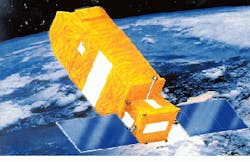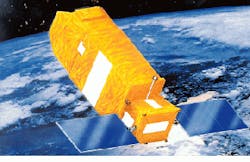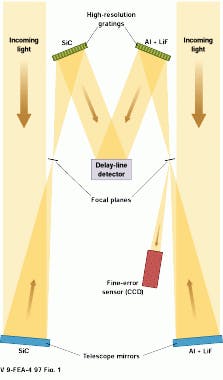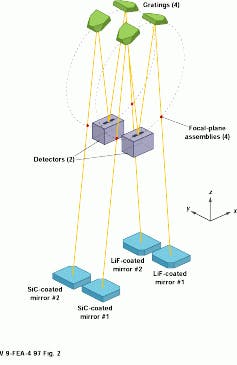Space instrument uses ultraviolet imaging to probe the universe
Space instrument uses ultraviolet imaging to probe the universe
By Lynn Haber, Contributing Editor
The Far Ultraviolet Spectroscopic Explorer (FUSE) instrument is slated to travel by satellite on a three-year mission to investigate the far-ultraviolet (FUV) wavelengths of 905 to 1195 angstroms (Å). In this relatively unexplored space wavelength region, scientists hope to find critical information about how the universe was formed. The spectral window opened by FUSE is also expected to permit the study of many astrophysically important atoms, ions, and molecules that cannot be otherwise investigated.
Paramount to the success of the mission is the design of the FUSE instrument, and specifically, maintenance of a key device feature--high spectral resolution--according to H. Warren Moos, principal investigator for FUSE and professor of physics and astronomy at The Johns Hopkins University (Baltimore, MD). "This requirement preserves the missions` capability to address frontier problems in cosmology and galactic evolution," says Moos.
The instrument`s design targets a spectral resolving power (l/Dl) of 24,000 to 30,000, providing the scientific community access to the designated spectral region. "This is a more difficult spectral region than, say, above 1200 Å, because what occurs in the 900- to 1200-Å spectral region is that it goes opaque, making observation difficult," claims Moos. Astronomers have wanted to explore this spectral region for several decades.
New frontiers
According to Johns Hopkins officials, another FUSE mission goal is to determine the abundance and processing history of deuterium in a variety of space environments. Deuterium, a type of hydrogen, is a crucial fossil nucleus, which many scientists believe was formed in the first few minutes after the Big Bang--the so-called beginning of the universe. Its abundance holds a key to unlocking the origin of the universe.
Yet another FUSE mission goal is to obtain direct measurements of molecular hydrogen, the primary constituent of the cold interstellar medium, where protostars--collapsing clouds of gas--and planets are formed. In addition, the FUSE mission is anticipated to provide important information on the hot phase of the interstellar medium, which occupies about half the volume of interstellar space and extends throughout the galactic halo. This halo of extended material is made up of hot gas and exists near the center of galaxies. All of these important measurements can be made only in the FUV spectrum.
Collaborative design
Johns Hopkins is responsible for developing the overall FUSE mission in collaboration with an international team of scientists and engineers from several companies and universities. Some US companies that are participating are Schott Glass Technologies (Duryea, PA), Swales Aerospace Engineering Co. (Greenbelt, MD), and Tinsley Laboratories (Richmond, CA). Participating US universities include the University of Colorado (Boulder, CO) and University of California (Berkeley, CA).
Because of government cuts in funding, Moos and his team had to redefine both the scope of the project and the instrument design, while incorporating enough high-priority FUSE science to make the restructured mission worthwhile. Initially, Moos expected to use a grazing-incidence telescope, but recent advances in coating technology allowed the FUSE team to use a normal-incidence telescope instead, at one-tenth the cost.
At short wavelengths, the light that falls on a mirror does not reflect well. But, if the light grazes, or skims, the mirror, as in a grazing-incidence telescope, it reflects better. However, a grazing-incidence telescope requires a large mirror that is cylindrical with some curvature, an efficient design that is expensive to manufacture. "The normal-incidence telescope is less expensive than the grazing-incidence telescope and doesn`t need to be as large to achieve the same efficiency," notes Scott Friedman, a FUSE project scientist at Johns Hopkins.
The optical design of the FUSE instrument includes four coaligned mirrors (approximately 39 ¥ 35-cm clear aperture) and two delay-line detectors (see Fig. 1). "Essentially, we split the large collecting area into four subtelescopes," says Moos. The light from the four optical channels is dispersed by four spherical, aberration-corrected holographic diffraction gratings and recorded by two delay-line microchannel-plate detectors. Two channels with silicon carbide (SiC) coatings cover 905 to 1100 Å, and two channels with aluminum and lithium fluoride coatings cover 110 to 1195 Å (see Fig. 2).
Actuators on the mirror mountings keep the focus to 90% encircled energy within 1.5 in. A fine-error sensor with a 21-sq ft field of view will maintain the spacecraft pointing stability to 0.5 in. Moos states that the present design eases fabrication tolerances on the optics, reduces the overall instrument length (to 4 m), and packages the largest possible mirror collecting area in the Med-Lite launch vehicle. Another important design benefit is redundancy. One disadvantage of the optical design is that all four mirrors and gratings must be accurately aligned, says Friedman.
High spectral resolution is obtained by a narrow "bright-object" slit. The highest sensitivity is expected to be achieved by a wider, high-throughput "faint-object" slit. The resolving power in this slit may be degraded slightly depending on how accurately the satellite can be pointed. According to Friedman, the FUSE team believes that it can hold the satellite pointed to 0.5 arc sec.
Less stability in the satellite could result in resolution degradation, or a jittery recording. Scientists, however, expect that image-processing techniques may allow restoration of the resolution in degraded data taken through the wide slit.
Using the fine-error sensor, every photon of light that falls on the detector will be recorded. "We can use the visible-light pointing data to correct for pointing errors that degrade the spectrum," says Friedman.
Timing is key
The university FUSE team faced several mission challenges: containing cost, maintaining design integrity and mission significance, and keeping reflectivity low while still using an all-reflective optical system. An important part of how the team was able to meet the challenges involved the implementation of advanced technology.
One incorporated technology breakthrough involves the availability of new reflective coatings such as SiC. Without these new coatings, short-wavelength light does not reflect well on a normal-incidence telescope. The new coatings allow the mirrors to work when light hits it straight on, without the need for grazing. "This allowed us to use normal-incidence optics," says Moos.
Another breakthrough involves holographic gratings. Most defraction gratings are made of grooved glass. For many years, these gratings were made with flat glass and straight grooves. However, the spectrum spreads out too much on the detector and causes an optical aberration. Holographic gratings correct these aberrations. During grating fabrication, the grooves are put down much closer on the glass by a holographic process than by the previous machine processes.
The high-density holographic gratings, which provide 600 lines/mm, are produced by Jobin-Yvon (Longjumeau, France). "The aberration-correcting capability reduces stigmatism by a factor of more than an order of magnitude," says Moos.
Yet another technology contribution is the availability of large, high-resolution UV detectors from the Space Sciences Laboratory at the University of California (Berkeley). This technology, which was demonstrated on the Soho and Orpheus missions, provides photon-location information with micron-level accuracy. The detectors use 10-mm-high by 90-mm-long glass microchannel plates, which contain numerous 12-µm-diameter holes.
For the FUSE mission, three microchannel plates are stacked so that when an ultraviolet photon, or light, hits a plate, a detectable electronic signal is generated on the bottom plate and provides measurable information. Because the FUSE spectrum of light is long and narrow, the university team places two microchannel plates side by side.
Furthermore, the team took advantage of the availability of new composite-structure materials that are lightweight and provide micron stability over distances of several meters to achieve an instrument mass of 780 kg. The derived composite material, called graphite cyanate, serves as the housing for the instrument components. "This composite material has a low coefficient of expansion and is less sensitive to water vapor than previously used materials," says Moos.
Although some of these breakthrough materials were used on the Hubble Space Telescope, their decreasing costs have enabled the team to save several important mission design objectives while making some compromises on the scope of the project. In fact, the team had to absorb a funding cut of approximately $150 million.
The most critical mission aspect that is retained is the capability to observe FUV spectra from distant astronomical sources in the 905- to 1195-Å wavelength range. According to scientists, this capability means that the FUSE mission can still determine the abundance and evolutionary history of primordial light elements and provide key data regarding the physical processes controlling the origin and evolution of galaxies, stars, and solar systems. In addition, because spectral coverages from 853 to 905 Å and 1195 to 1248 Å were eliminated, the high-spectral-resolution measurements to be made over the limited wavelength region have simplified the design and cost of the detectors.
Also eliminated is the low-resolution imaging channel that was planned to cover the range of 500 to 1600 Å. This so-called survey channel included a separate detector and a reduction in the number of detector segments from three to two per detector. Other changes included accepting reduced pointing stability, which may lead to increased observing times when using the narrowest spectrograph entrance aperture, and eliminating or combining certain tests and calibration procedures during the integration phase.
The most important change in the mission design is the selection of a low earth orbit that is driven primarily by the capability of the Med-Lite launch vehicle. The two most important implications of low earth orbit are lower observing efficiency and a more benign radiation environment, which allows the use of commercially available subsystems. The baseline orbit is now a circular one of 800 km altitude and 25 inclination from Cape Canaveral, FL, in the fall 1998. The circular orbit of the Shutttle spacecraft was 300 to 400 km.
FIGURE 1. In the Far Ultraviolet Spectroscopic Explorer instrument, light from the science target arrives at the telescope mirrors. A pair of mirrors, one coated with silicon carbide (SiC) and the other with both aluminum (Al) and lithium fluoride (LiF), focus the incoming light onto the focal planes or entrance slits to the spectrograph. These coatings maximize reflectivity over the 905- to 1195-Å bandpass. The light passes through the slits and illuminates high-resolution diffraction gratings coated with the same materials used for the mirrors. The two resulting spectra, slightly separated to avoid confusion, fall on a single microchannel-plate delay-line detector. The CCD-based fine-error sensor views the stars near the science target to maintain proper pointing of the satellite. The other two identical optical channels are positioned in an adjacent location.
FIGURE 2. The primary optical components of the Far Ultraviolet Spectroscope Explorer (supporting structure is omitted here) include the spectrograph, which is a Rowland-circle design with a diameter of 1.652 m. The telescope mirrors are off-axis parabolas, each with a focal length of 2.245 m. Each telescope mirror has three actuators for tip-tilt-focus adjustments. The focal-plane assemblies, each of which contains several entrance slits for the spectrograph, can also be adjusted in the x and y directions to maintain coalignment of the four optical channels.
Higher mission capabilities
Whereas the FUSE mission is projected to break new scientific ground, it will also complement missions carried out in other wavelength regions. For example, in the early 1970s the Copernicus mission provided the first glimpse into the far-ultraviolet region. However, that mission`s range was limited to relatively nearby stars, only some of which were bright enough to allow observations below 1000 Å. Copernicus was the last mission to explore the far-ultraviolet region of the electromagnetic spectrum at high resolution.
Two telescopes, HUT and ORFEUS, which have been flown on previous Shuttle missions, also provided some brief glimpses into the far-ultraviolet wavelength region. However, these instruments possessed moderate resolutions; HUT had a resolution of 5000 and ORFEUS 500. In addition, these telescope observations were limited by the duration of the Shuttle missions, just a few weeks.
To extend capabilities, the sensitivity of the FUSE instrument, as measured in terms of effective area, has been expanded to 80 cm2. In comparison, the HUT telescope sensitivity was 30 to 40 cm2, and the ORFEUS telescope was just 5 cm2. In addition, the FUSE instrument has capabilities vastly greater than that of Copernicus, and the range of its observations will stretch beyond the earth`s galaxy to distant galaxies and quasars.
According to H. Warren Moos, principal investigator for FUSE and professor of physics and astronomy at The Johns Hopkins University (Baltimore, MD), FUSE will have an effective observation area ten times greater than that of Copernicus, which was a pioneer mission in 1972 and had an effective observation area of 3000 light years (one-eighth the distance from Earth to the galaxy), a much lower detector background, and the ability to record the entire 905- to 1195-Å wavelength region simultaneously at higher resolution.
In contrast, Copernicus collected data in a single element detector at a time. Moreover, the more efficient FUSE will be able to collect data over the entire angstrom region at once, whereas Copernicus needed 20 steps. Overall, FUSE is expected to provide an effective sensitivity of more than 10,000 times that of Copernicus.
L. H.



